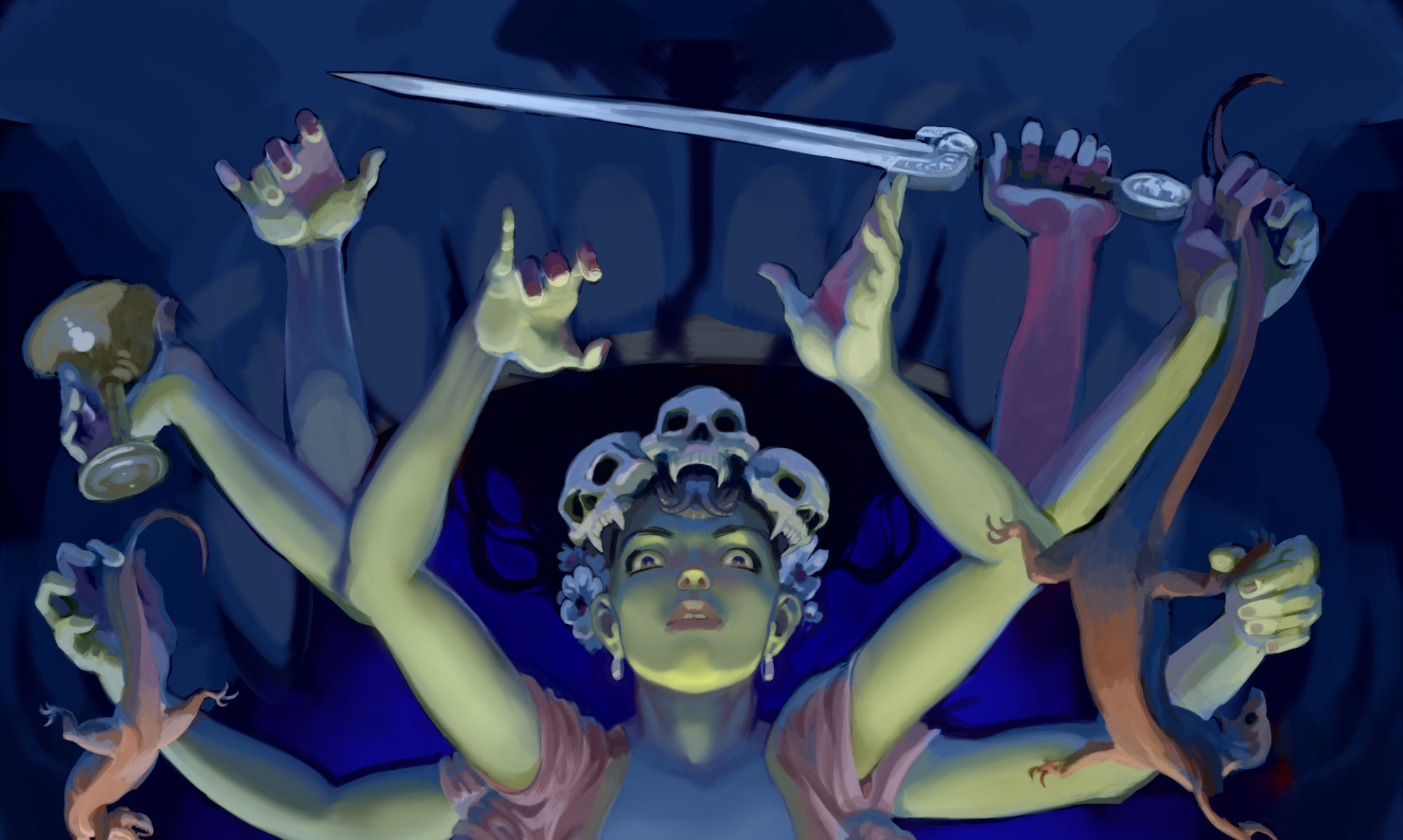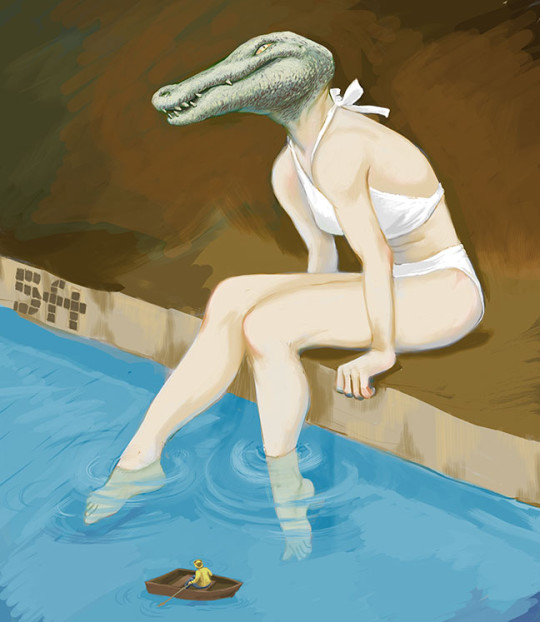I haven’t had much time to paint since starting up Unicorn Soup. But I did bring an extra tablet to work, and work on digital paintings during downtime. Here’s a recent one.
Electric Kali: Progress. Also, Tim Knight is a Great Guy.
Making progress, slowly but surely. I’ve spent less time with this painting lately because I’m working on a new webcomic project, and Portal 2 came out. Seriously, buy this game. It’s excellent. More on the webcomic later, once the project is a little farther along.
Here’s the final sketch for the painting. You can see that the background and some supporting details are missing or not fully realized. These will come as I paint. Mostly the sketch is to work out the basics. It was important to me that I choose the right guitar and amp combo for this image– it will matter little to most people, but I wanted to avoid just painting a generic “guitar.” I want to render something that a guitar fan will recognize and drool over.
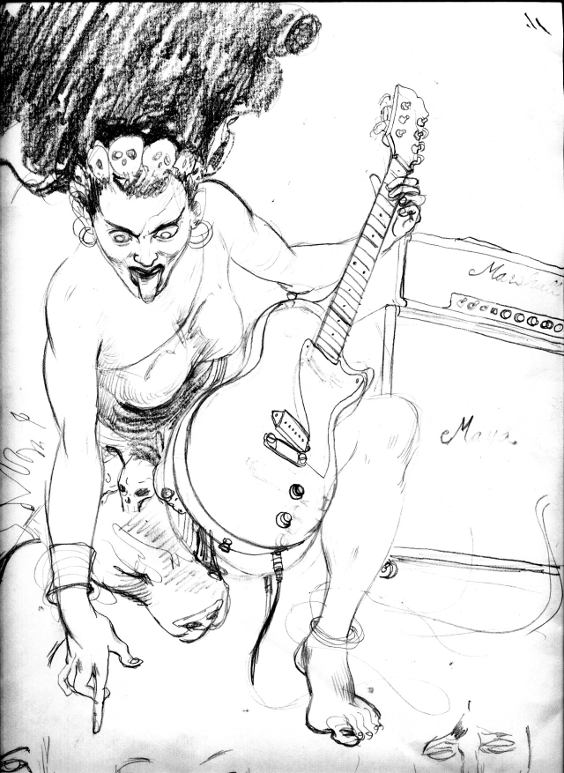
After much hemming and hawing, I finally decided on a 50’s Gibson Les Paul Junior, and a 70’s red Marshall half-stack. The guitar is simple, pared-down to the essentials, but one with a very powerful voice. A true rock guitar. Marshall amps are of course the defacto symbol of rock; big, loud, screaming distortion. The red models they made in the 70’s are gorgeous, and I prefer to paint a big red amp than a boring black one. This guitar and amp combo represents power, aggression and fury quite well, I think.
It’s fairly easy to draw a generic guitar. But to draw a specific model recognizably is particularly difficult, at least for me. I was resigned to using a google image search for reference, but was discussing my choice of equipment with the inestimable Tim Knight, who had something much better in mind. Tim doesn’t have much of a web presence, which is a shame; he’s a cultural asset here in Salem, Oregon. Tim owns and operates Guitar Castle, a vintage guitar store downtown, and co-founded (but is no longer a partner of) Ranch Records, Salem’s best record store. Tim is a great musician; he played and recorded with John Fahey, is a member of the Hundred Dollar Jayhawks, the Nettles, and the Bohemian Enclave, which is his latest project. He helps organize local shows with local talent, and records and advises young up-and-comers. He’s friends with and sold guitars to many great musicians, and has countless great stories to tell.
I love Guitar Castle because there’s always a little bit of history on the racks there. While it is a vintage guitar store, Tim stocks guitars and amps for players, not collectors. For example, I bought a wonderful 1962 Fender Jaguar from him last year. It’s all original, but for one thing: a previous owner had stripped off the sunburst finish and sprayed it with clear nitro. This destroys its value as a collector’s item, but drops it neatly into my price range. A pre-CBS guitar that I can afford and sounds like a dream! (I’ll post more about this guitar some other time.) These kinds of deals make the store unique, and a great place to browse. Tim is also a painter, and his art is on the walls there. He paints scenes and portraits in a “naive” style, and his abstracts (my favorites) are colorful, thoughtful and emotive. (He also has a couple of my paintings hanging in the store. Thanks, Tim!)
When I told Tim the guitar and amp I had decided would be in Electric Kali, he laughed. “You mean like the ones in my basement?” he said. “Why don’t you shoot them for reference?” Tim Knight is a great guy. I came back a week later with my camera.
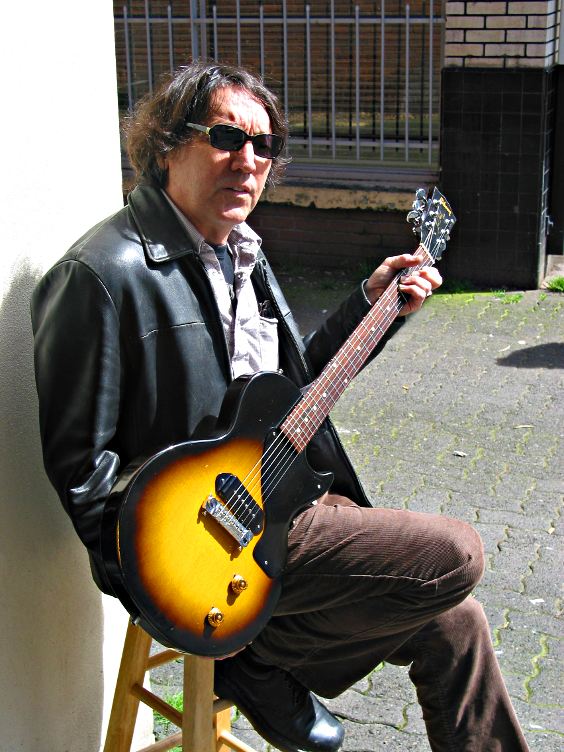 Here’s Tim with the Les Paul Junior. It’s no longer in the basement, it’s behind the counter, for sale at a bargain price.
Here’s Tim with the Les Paul Junior. It’s no longer in the basement, it’s behind the counter, for sale at a bargain price.
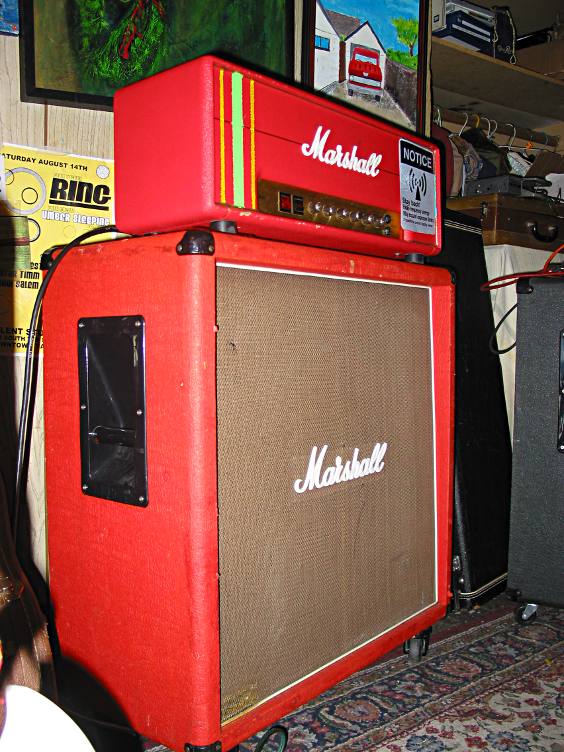 Tim’s red Marshall. Alas, this one is not for sale.
Tim’s red Marshall. Alas, this one is not for sale.
With the reference shot at just the angles I wanted, the sketch came together much faster than cobbling together images from the web. With the drawing done (more or less), I transferred it to a panel, and painted in the basic values using burnt umber and ultramarine. Now I’m roughing color in over the values, using glazes of varying opaqueness. The drawing is still visible a bit under the color, which will allow me to tighten up the detail once I’ve got the overall composition and color where I like it.
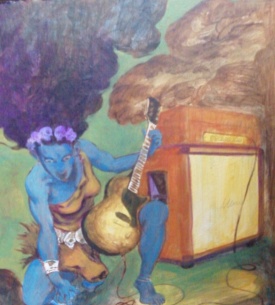
I like to work this way rather than make a color rough, because when I change my mind about a color and paint over it, the previous layers all build up to make a richer finish with more depth than if I just started with the right color first. More images to come as I continue to paint!
John Lee Hooker: Badass

Queen of the Beasts
Here’s a painting I made for my wife late last year, for her birthday. Godzilla, you done got knocked the #*@$ out!
The white marks scattered across her head are from paper left atop the painting before the varnish had completely cured. The paper stuck to the varnish enough to rough it’s smooth surface when it was pulled away. It’s easy to repair– just sand them down and re-varnish. It’s what I get for painting it and gifting it last-minute. Acrylic really needs at least a good week after it dries to cure properly.

Electric Kali sketch fragment
“Woman, in the picture language of mythology… is the guide to the sublime acme of sensuous adventure. By deficient eyes she is reduced to inferior states; by the evil eye she is spellbound to banality and ugliness. But she is redeemed by the eyes of understanding. The hero who can take her as she is, without undue commotion but with the kindness and assurance she requires, is potentially the king, the incarnate god, of her created world.”
–The Hero with a Thousand Faces, by Joseph Campbell
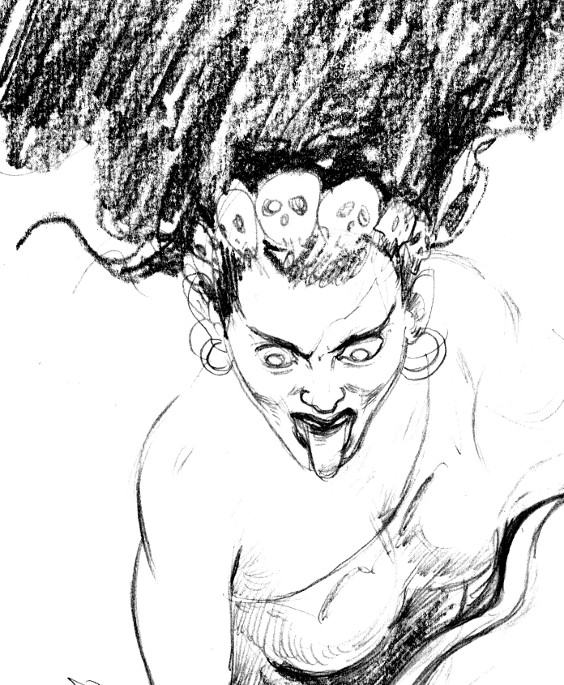
Studies – Electric Kali
I’m working on another painting of Kali. Below are some studies. Kali’s grimace is a challenging expression to illustrate– it may not really exist in reality. Each of these faces has an element I want in the painting, but none of them are exactly what I want. This is often the way of using reference– you have to extract from it the details that you have trouble visualizing, but the final synthesis still has to go on in your head. Often being too true to your reference (at least in fantastical paintings as I tend to make) just ends up being a painting of someone dressed up as a goddess, rather than the goddess herself.
Kali is a theme I return to often. I’m not a Hindu, nor are my paintings of this Hindu Goddess particularly honest or true to the religion she comes from. But the idea– this personification of the destructive element of the female; the recognition that to be alive means someday to die; this cosmic mother that gives life to all, yet beheads and devours her children… well, let’s just say she’s a potent symbol, and has much to offer to a simple painter like myself. Being raised a westerner, a destructive, powerful and deadly female– who isn’t a villain— is extremely novel, and as such, fascinating. Each of my paintings of her grasp a different tiny shard of her meaning, letting the rest, the really important parts, slip away. I suppose that’s why I keep coming back. Next time I might be able to hold onto more.
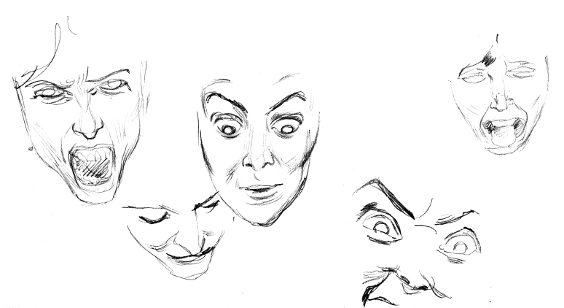
Pele Demands a Sacrifice!
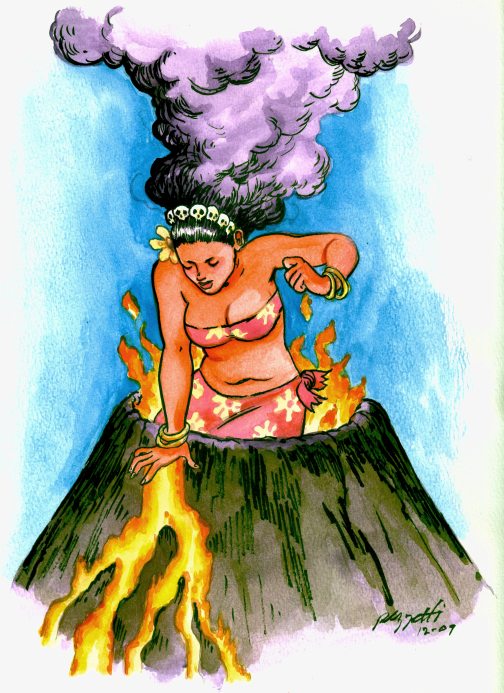
Zombies!
The Walking Dead are the classic movie monsters I was most frightened of as a child. Ever since the nightmares I had after studying pictures of Tutankhamun’s dessicated mug when I was 7, I’ve been fascinated by zombies. You may have noticed that shamblers are experiencing a sort of renaissance in pop culture. Really, they never went away, but particularly in video games, there are more zombie games now than ever. And I love it. To be honest I’m a little surprised I’m not bored with the idea of shooting zombies by now. But almost every night I find myself playing zombie video games.
These aren’t actually zombies, rather they’re mummies from Palermo. I used some of the magnificent photos here as reference. Mummies are fascinating to me as well, and they’re full of little details you can use to make your zombies a little more life- err, deathlike.
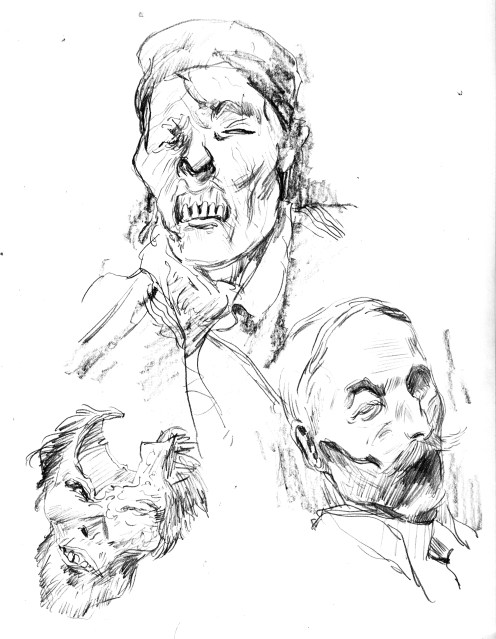
Drought
We have cats. Have had ’em for about a year now. Cats have hair. Lots of hair. It gets everywhere. Particularly into my paintings, sticking to acrylics and oils, anything that stays sticky for at least 30 seconds. I’ve tried vacuuming (the house and the cats), different ventilation/filtration approaches. Just like entropy, cat hair is inevitable and everywhere.
So watercolors it is, then. The media I most neglected in art school. My own damn fault really, we had some teachers who were absolutely amazing with the medium. Me, I’ve got a lot to learn. Here’s a couple of versions of an illustration, with me experimenting. Watercolors and sumi ink.
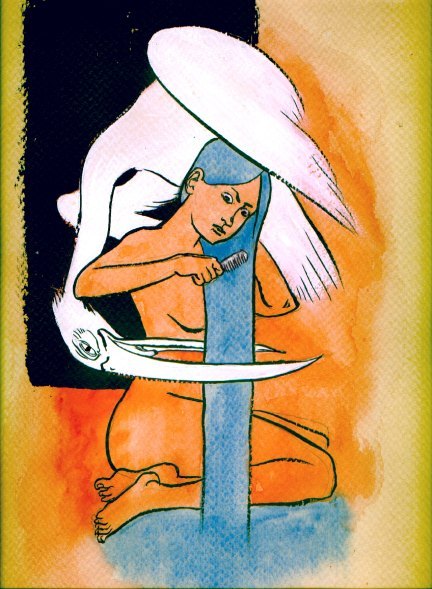
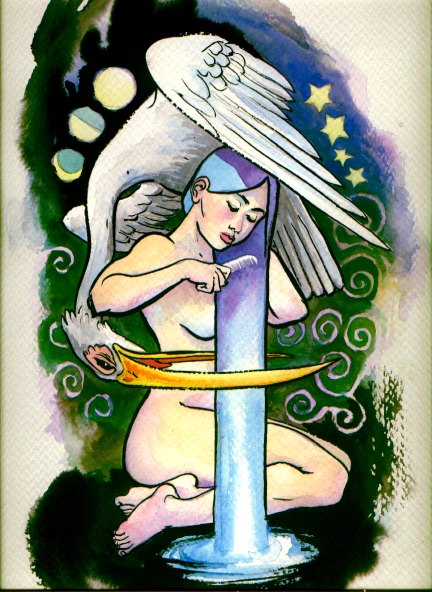
Pure Voodoo: Normandy Guitars
Guitarists are a notoriously conservative lot. Innovative ideas in guitar design generally don’t meet a warm reception. The most popular guitars are styled after 40-year old designs, and materials haven’t changed much. So a new company like Normandy Guitars has an uphill battle. Normandy’s necks are still wood, but the bodies are made from aircraft-grade aluminum. That’s kind of a big deal in the guitar market. But so far, Normandy Guitars is doing well, selling around the world, and online at Amazon and Musician’s Friend. Their guitars sound great in their own right, a very classic well rounded warm sound, nothing as outlandish as one might expect given the materials. And they are absolutely gorgeous. You can see that they’re going with classic styling, in part to keep their foot in the door with the conservative majority of the guitar-buying market.
Jim Normandy, the founder, lives in my town, and I managed to talk my way into helping out with some of the company’s design needs. I’ve done some ads for them, and a poster, which I’m quite proud of.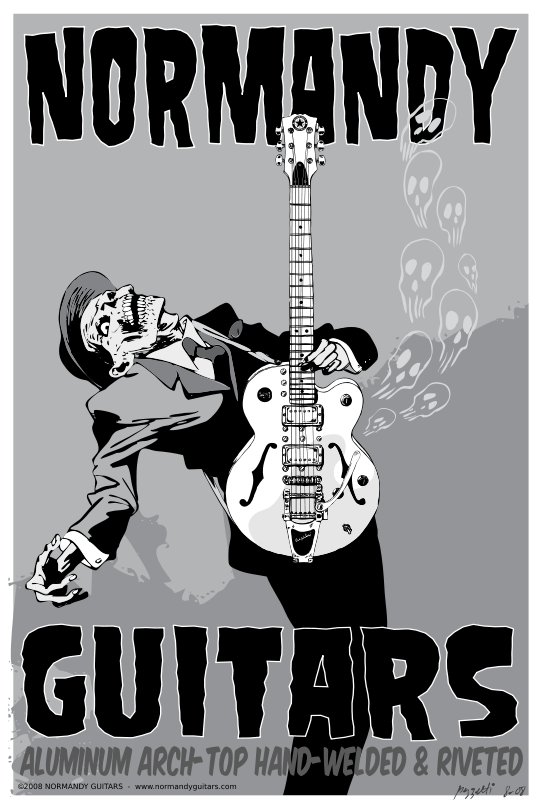
You can download a high quality pdf from Normandy here. Mine’s the one on the right.
